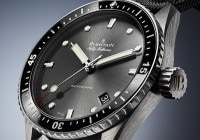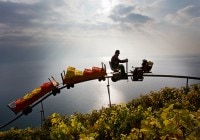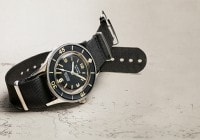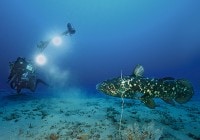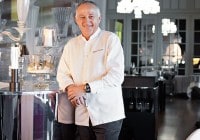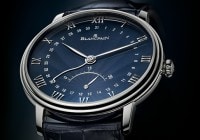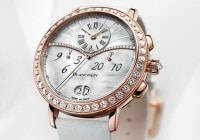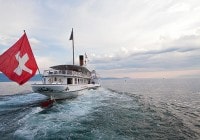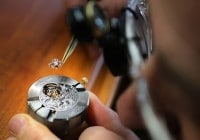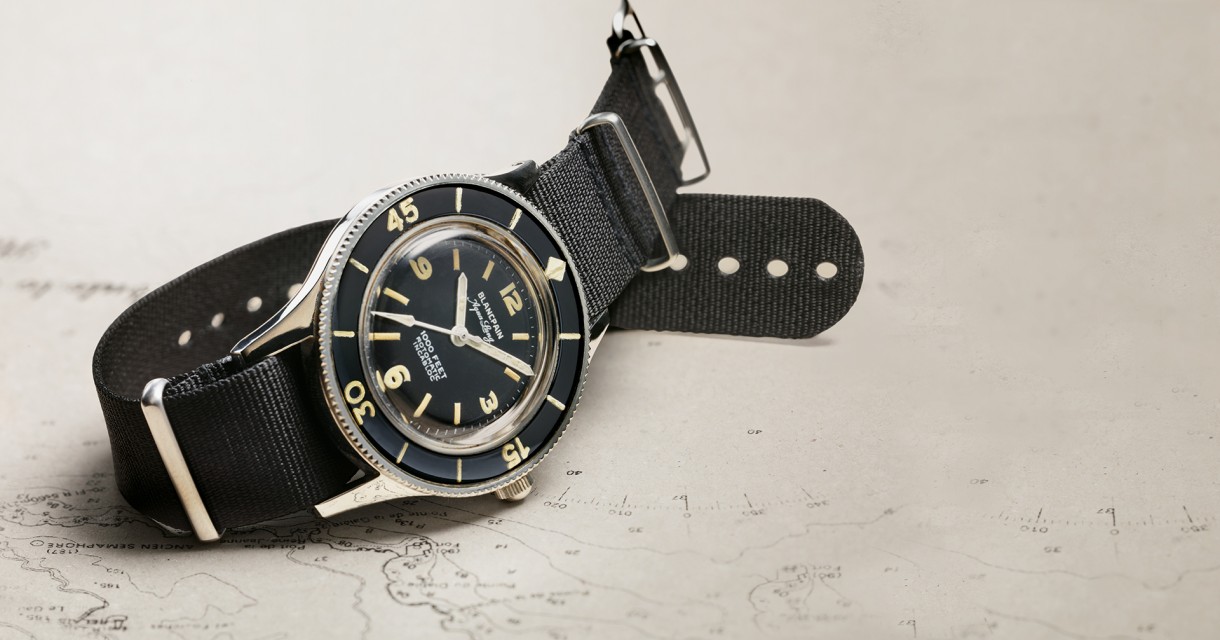
Search in Issues
Chapters
List of parts
Chapter 2
DÉZALEY and the LAVAUX
After decades of “radio silence” from the wine press, Switzerland’s Dézaley wine vaults to center stage as one of Robert Parker’s 2012 wines of the year.
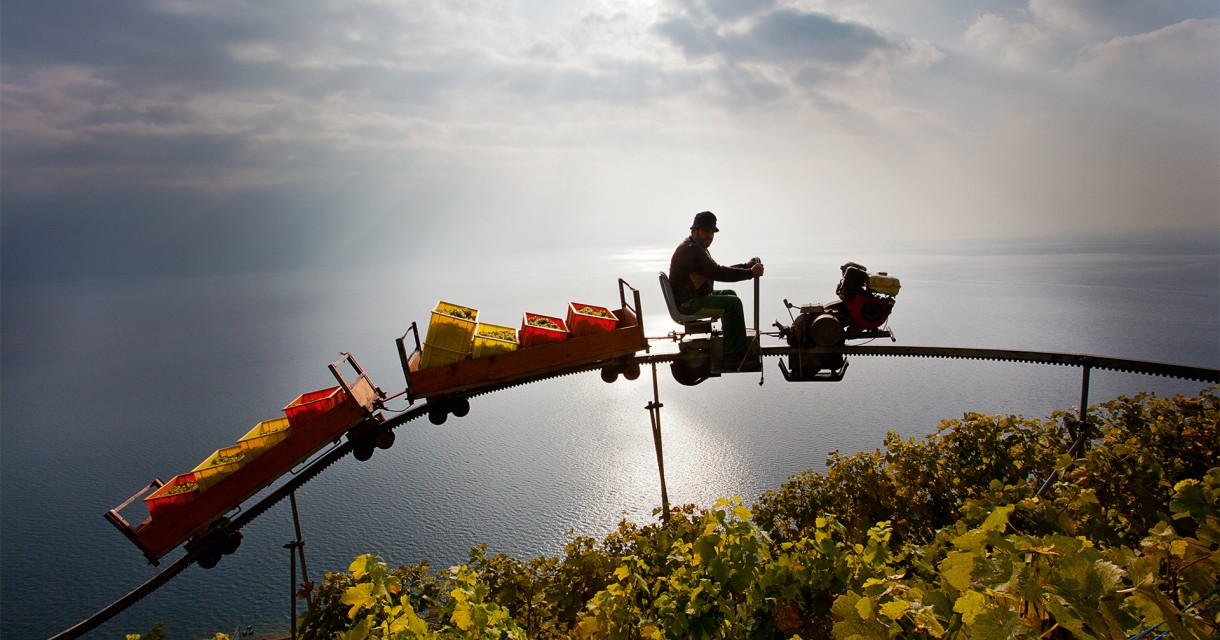
Indulge a flight of fancy for a moment. Conjure the images of the world of aristocratic wine making. A sprawling Chateau, discreetly overshadowed by Versailles, but not by much (no sense upstaging the King when France still had one), flat, easily tended vineyards as far as the eye can see, gleaming cellars teaming with staff, a world-wide distribution apparatus to rival that of IBM, yearly visits by Robert Parker and homage paid with tasting notes spanning decades of vintages. Oh, and let’s not forget, an entire chapter in his book devoted to you! Ah! The bliss of it all.
Then imagine wine making in Switzerland’s Lavaux and in particular in Lavaux’s grand cru vineyards of Dézaley. Beginning just past the borders of urban Lausanne and extending nearly to the Chateau de Chillon, on the outskirts of Montreux, the Lavaux vineyards soar up from the shores of Lac Leman and at the approximate midpoint lies Dézaley clustered around the microscopic village of Épesses. In place of the chateaux are humble non-descript country dwellings. Banish any thought of a tranquil autumn stroll through the turning leaves of the vines, as the slopes of the Lavaux are terraced into what in many places are dizzying, acrophobic 90 degree pitches held in place by 10,000 stone terraces which combined are 400 kilometers in length. Total elevation rise? 300 meters. Often the terrace walls enclose only enough soil for a single row of vines. No choice, as labor must be accomplished by hand, painfully upon the frightening perches, and without being too mercantile on the point, at high Swiss wage rates. As for distribution, nary a bottle leaves Switzerland. And that chapter in Robert Parker’s book? Hasn’t been written. In fact, if it is accolades in the wine press or even the gourmet food press you’re looking for, Dézaley — throughout its millennium of viticulture — has not been the place. For all the obstacles — the cliffs, the walls, the perilous expensive hand labor — what’s the reward? Radio silence from the world’s wine journalists and critics.
Until just now.
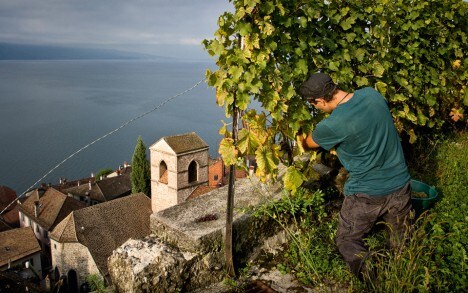
The village of Saint-Saphorin in the Lavaux.
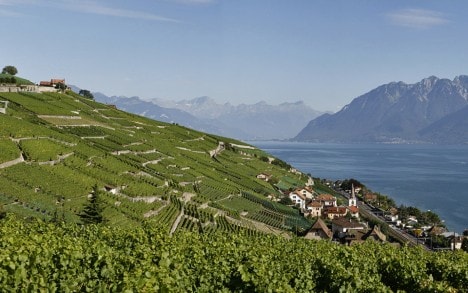
Vineyards of Villette. 80% of the Lavaux is planted in Chasselas.
Wine making in Dézaley dates to the 12th century when CISTERCIAN MONKS began terracing the hillsides.
Then in January 2013 Parker’s guide placed the Dézaley Haut de Pierre 2010 from the Domaine Blaise Duboux on the list of “Best of 2012” wines. Ever the king maker and kick starter of buying frenzy with high scores (and sowing ruin with low ones), Parker predicted not a moment of rest for Blaise Duboux until he found an American importer for his wines.
For three decades Robert Parker has single handedly ruled the world’s markets for fine wine. Although the Chasselas from Dézaley for nearly all of this entire time escaped his attention, the Swiss have long prized these lush, long lived whites. It is here in Dézaley that the Chasselas grape finds a perfect marriage of soil and microclimate.
Wine making in Dézaley, in common with rest of the Lavaux, dates to the 12th century when Cistercian monks (who migrated to the region in the 11th century from the Burgundian Abbeys of Cîteaux and Vougeot) began terracing the slopes above Lac Leman. Wine making came under the jurisdiction of the Bishops of Lausanne through two Cistercian abbeys: Abbey de Hauterive and Abbey Hautcrêt. It was their labor that built terraces and roads throughout the Lavaux. Of course, governance means regulations, and even in the 12th century this axiom held true. One document from the period defining how terraces were to be constructed describes terrace widths of 10 to 15 meters (although many are much narrower than that) to be supported by stone walls 5 to 6 meters in height and further prescribes that wine makers were to be required to maintain the walls and control water runoff. Over the next 800 years, viticulture in the Lavaux gradually subdivided into a patchwork of small plots that were both expensive and difficult to maintain. Change came after 1803, when Lausanne was made the capital of the canton Vaud. This led not only to improvements in the terraces and roads, which finally allowed connection between the many small wine villages, but eventually the construction of a system of railroad links. All of this unique history, together with the striking landscape and preservation of ancient terraces, led UNESCO to declare the Lavaux as a World Heritage site.
One can ponder whether it was purely happenstance, blind luck so to speak, or remarkably penetrating insights that motivated the monks to choose this terroir for their vineyards. Whatever the motivation, their hand labors to build rock terraces upon the hillside cliffs created a remarkable recipe for fine winemaking. Upon the steep slopes, the soil itself is unique in that it represents the remains from glacial activity that

Manual harvesting with crates in Luc Massy's vineyards.
WHATEVER THEIR MOTIVATION the monks' hand labor to build rock terraces upon the hillside cliffs created a remarkable recipe for fine winemaking, which given the passage of the centuries, has led to recognition of Dézaley as one of Switzerland's first two grand crus.
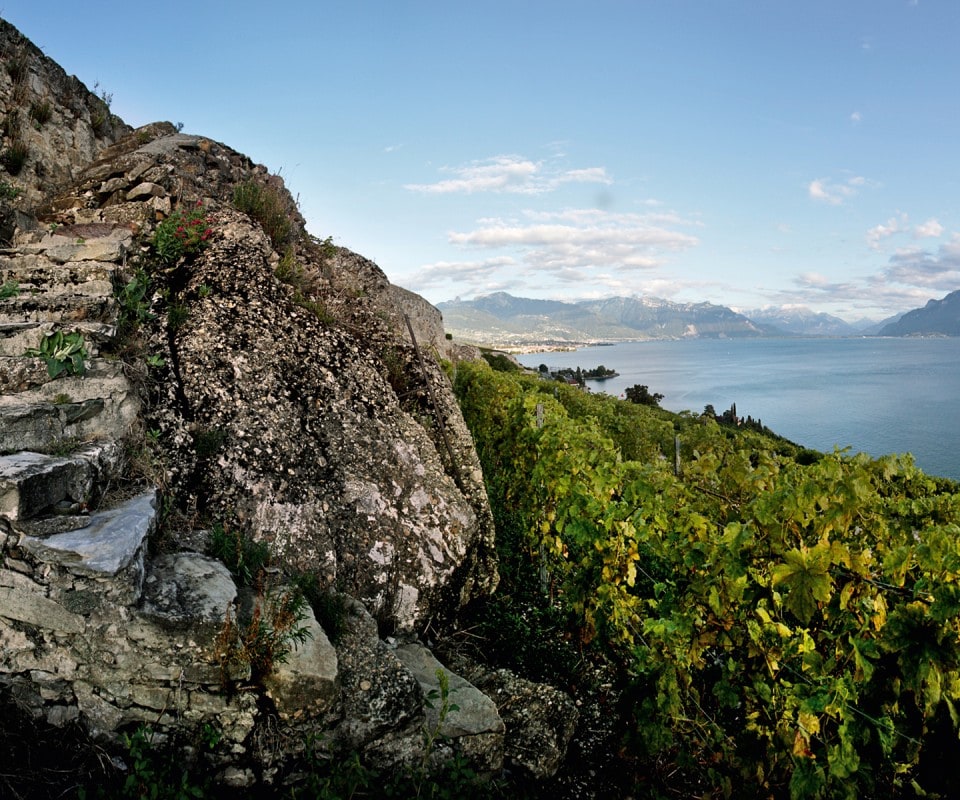
The Lavaux countryside near Saint-Saphorin, classified as a UNESCO heritage site on June 28, 2007. Much is owed to those who built the terraces, stairs and masonry walls, which are different from the dry stone walls built in the Valais.
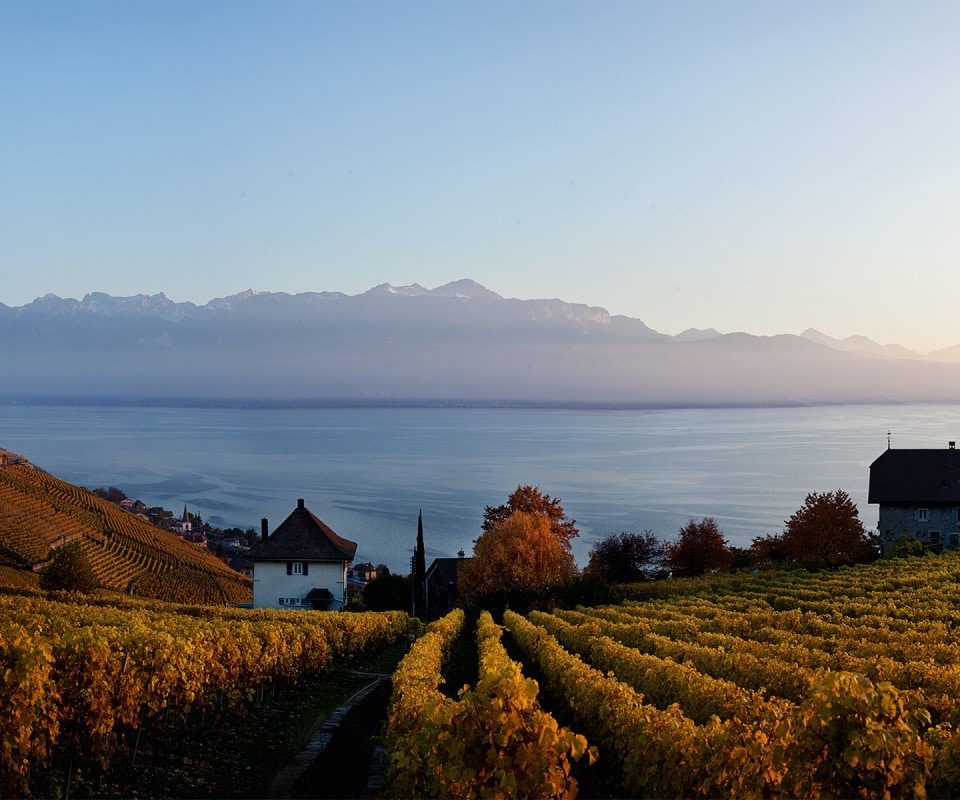
Many areas in the Lavaux are under public ownership and are often located outside of the vineyards such as the Domaine de Montagny, shown on the right of the photograph, which belongs to the Payerne Municipality.
Dézaley was cleared and planted with vines by Burgundian monks at the beginning of the 12th century. Later after the Reformation (1536), the City of Lausanne, the capital of the canton of Vaud, inherited two prestigious estates, the Clos des Moines (shown in the middle of the photograph) and the Clos des Abbayes (shown at right). Their wines have been sold at auction each December since 1803.
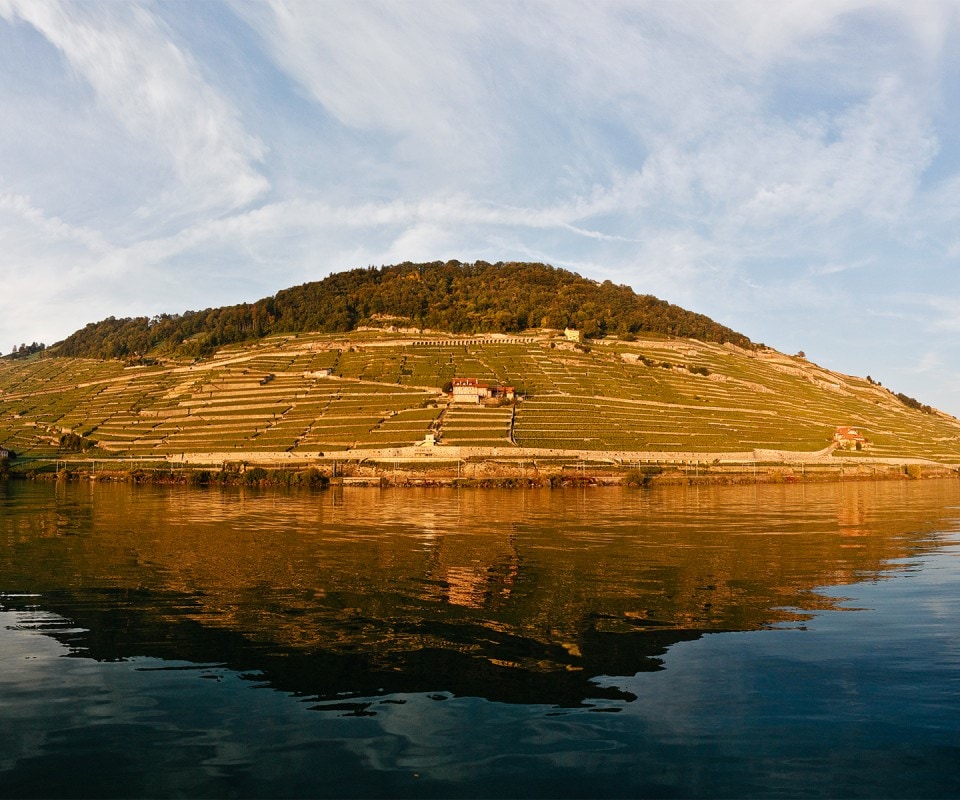
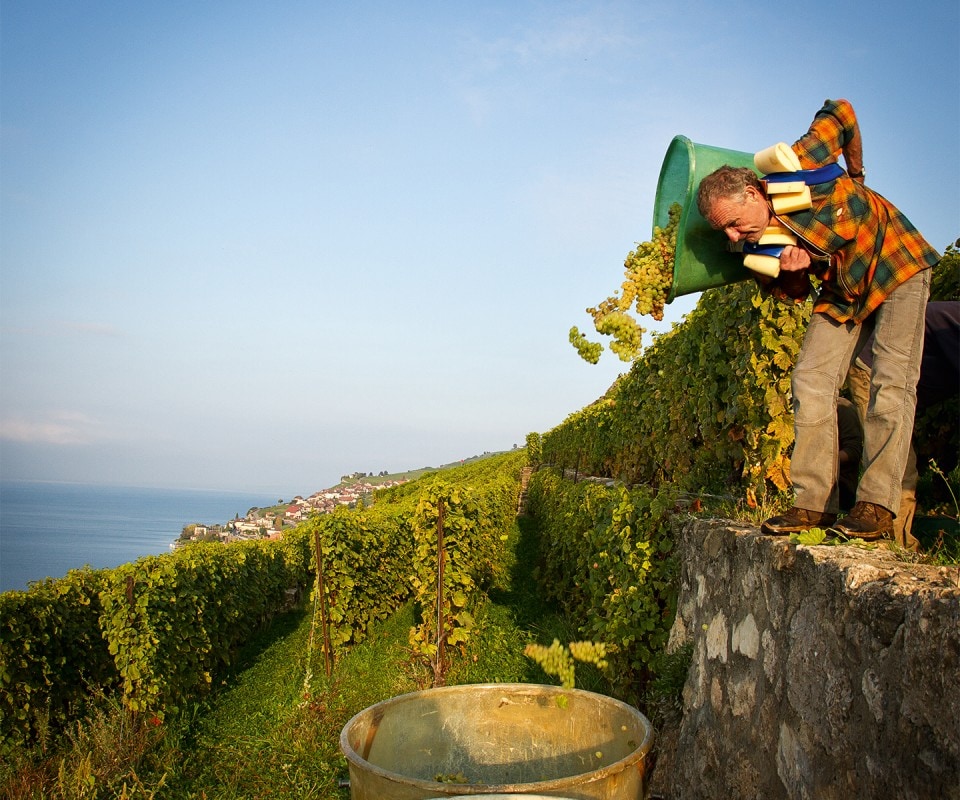
Harvest in Saint-Saphorin at the Domaine des Faverges which has the largest landholding in the Lavaux (15.4 hectares) and which is owned by the canton of Fribourg. This is one of the oldest estates in the region and is mentioned on a parchment dated February 25, 1138.
oxygenated the ground-up rock. With an exposure oriented to the southwest, Dézaley is bathed in not only the late afternoon sun, but, as well, abundant warm reflections and breezes off the lake itself. As the general climate is not excessively hot, remember this is in the Swiss Alps, after all, the sun orientation and lake reflections permit extra hang time of grapes before the harvest, allowing greater phenolic maturity than Chasselas grown elsewhere.
It matters not whether the Cistercian monks fully understood this distinguished combination of soil, slope, orientation and reflection, the Swiss vignerons have over the centuries recognized what they have. Perhaps the most resounding endorsement of virtues of the Dézaley terroir occurred when, after centuries of Helvetic viticulture, a system of ranking vineyards, akin to that which has reined in France, was put in place in the late ’80s. Dézaley, 53.8 hectares, was one of the first two appellations accorded the coveted status of “grand cru,” the top.
Lettres du Brassus is delighted to enlist renowned Swiss wine expert, Pierre Thomas, to profile four of the leading Chasselas Dézaley vignerons, Blaise Duboux, Louis-Philippe Bovard, Luc Massy and Les Frères Dubois et Fils.
THE LAVAUX is bathed in afternoon sun and breezes from lac Léman.
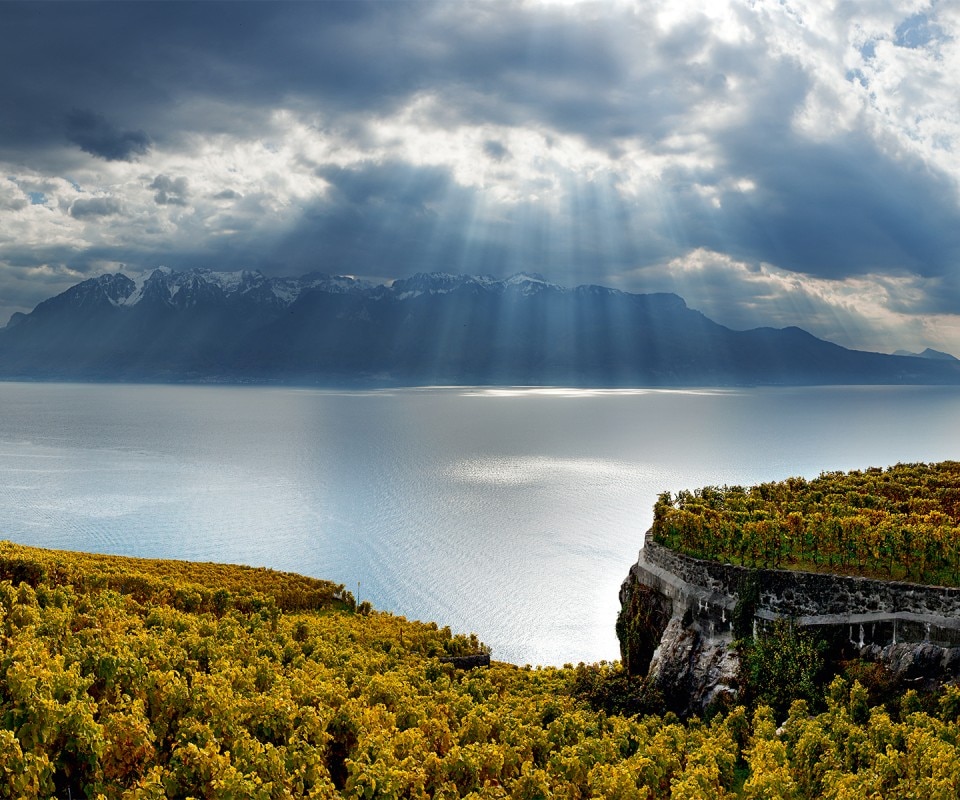
Vineyards above Saint-Saphorin.
It is said that the vineyards in the Lavaux benefit from “three suns”, that which shines in the sky, that which is reflected in Lake Geneva, and that which is reflected by the rocks and walls. In the background the Savoy mountain in France.
A Quartet from THE DÉZALEY
With less than 54 ha and about sixty labels, the Dézaley is a grand cru that rejoined the canton of Vaud AOC in the spring of 2013 after three years spent in the 809-ha Lavaux AOC. While a single varietal predominates (Chasselas accounts for 90% of vineyard acreage), the nature of the sub-soil, direction of slope exposure and density of planting are just some of the parameters that each wine-grower handles in his own way, just as he selects his own wine-making methods in the secret confines of his cellar. To illustrate this heart of the Lavaux region for the Lettres du Brassus, Pierre Thomas has chosen to paint a portrait of four of the Dézaley’s iconic estates.
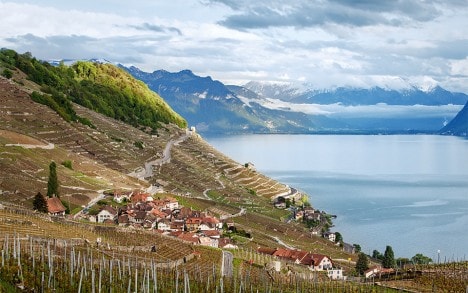
Épesses and Dézaley. At left the Clos du Boux with its poplar, the residence of the Massy family.
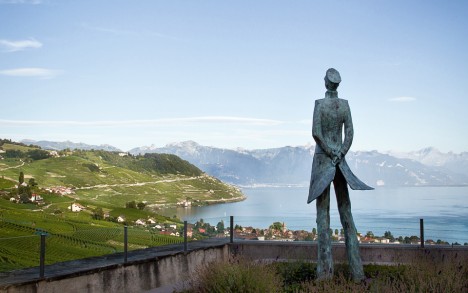
Grandvaux honors the memory of artist Hugo Pratt, creator of the immortalised cartoon character, Corto Maltese.
Luc Massy: A LOCOMOTIVE The Massy family has succeeded in establishing THEIR BRAND, THE DÉZALEY CHEMIN DE FER.
In Switzerland and Germany, as in Japan, Dézaley Chemin de Fer is one of the few well-known Swiss whites—and has been for a long time. For while the Massys did not settle in Épesses until 1903, which is nothing compared to the lineage of other wine-growers, they were the first to bottle their wine, beginning in the 1920s, rather than selling it in bulk from casks at local cafés and restaurants...
The first of the “Massy wine-growers,” after having traveled in Africa and contracted malaria, worked in the Vallée de Joux, in a shop founded by one of his ancestors who produced jewel bearings for watchmaking—a fact that will not be devoid of interest to readers of the Lettres du Brassus. Then, seeking a better future, he came to try his luck on the shores of Lake Geneva. Having married a girl from Épesses, Luc Massy explains, “my grandfather immediately thought of the brand: his inspiration was to call it ‘Chemin de Fer’ [Railroad],” after a parcel acquired in a locale of that name, so christened because the Paris− Simplon railway line had just been finished.
Today, the roughly 35,000 bottles of Che- min de Fer still come from this same 3.5-ha combe not far from Vinorama, the showcase and wine bar for the Lavaux vineyards, along the lake road from Lausanne to Vevey, set back from the railway line. When the president of the Barony of Dézaley is asked what has changed in his cellar since his grandfather’s time 110 years ago, he replies quick as a flash: “Nothing! Between the alcoholic and malolactic fermentations, we leave our wine on the same lees. We don’t move the wine, it stays with its ‘foster mother’ from October until March.” In March the wine is pre-filtered, then bottled three times a year, at the end of May, in July, and in September.
Another characteristic is that only a third of the wine is aged in a large cask. Luc Massy is proud to show off “his” cask in a naturally cool cave hollowed out of the rock at the entrance to the village of Épesses. “I treated myself to it in 2002, for my 50th birthday. A gift that cost 45,000 Swiss francs!” With barely disguised irony, the master of Chemin de Fer declares: “Dézaley is the locomotive of Vaud wines! Consumers don’t always understand that it has more flavor and costs more than other chasselas. For me, Dézaley has always been an extraordinary wine because of the way the terroir and the climate come together. In fact, the Barony of Dézaley was created in 1994 to drive home the point!”
Sold for 24 francs on the estate, this great white wine—which as we are now dis- covering not only ages well but develops along the lines of old champagnes—seems to be quite a “deal” for a grand cru. “We are not daring enough, because Dézaley does not have the image,” confesses Luc Massy, who has every vintage since 2001 available in his cellar. The fourth generation is now in place. After vitivinicultural studies and internships abroad (at Colomé in Argentina), Benjamin, 29, returned home a few months ago.
www.massy-vins.ch
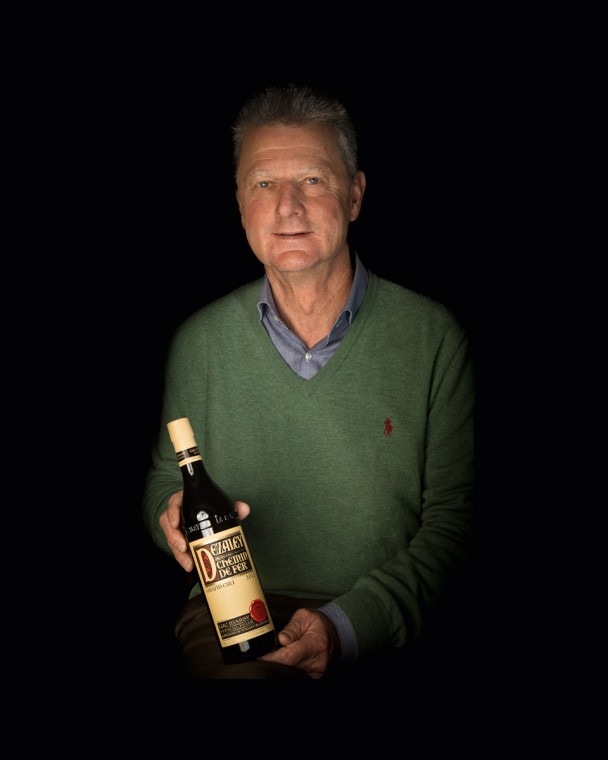
Louis Bovard Estate: TRADITION AND IMAGINATION Of all the wines signed Bovard, Dézaley “LA MÉDINETTE” remains the standard-bearer.
In 2010, Louis-Philippe Bovard celebrated his 75th birthday by opening a small cellar in the old village of Cully on the shores of Lake Geneva. It is equipped for making a large number of wines in small amounts. For, champion of chasselas though he may be, Louis-Philippe Bovard—a man whoseeffervescent spirit bubbles out from behind his severe glasses and sailor hat—is first and foremost a tireless trailblazer.
As a gentleman farmer of this estate that dates back to 1684, he has surrounded him- self with professionals in both the vineyard and the cellar. In early 2013, promising Alsatian wine-maker Philippe Meyer (of the Josmeyer family, see Lettres du Brassus No. 12) became a “cantonal enologist” tasked with advising wine-growers throughout the Vaud region. He was replaced by Caspar Eugster, who has international experience (Hess estates).
Of all the wines signed Bovard, Dézaley Médinette (35,000 bottles per year) remains the standard-bearer. This brand intrigues even French-speakers. Its name is taken from a temple of Luxor, in Egypt, and also matches the androgynous silhouette of a Bacchus, looking almost like a young girl(midinette) from the 1905 Vevey winegrowers’ festival. This label, which Louis-Philippe’s grandfather accentuated with the phrase “the finest of Swiss wines” done in gold letters, has never changed since. At the very most, the 1990s saw the appearance of Warholesque-colored labels—blue, red, green, or yellow—to differentiate the vintages, because while the notion of terroir is dear to Louis-Philippe Bovard’s heart, the special characteristics of each year are dearer still. Ask him how the vines were doing in, say, 2001, and he will pull out his notebook: “It was a late year, a hot summer with rain before the harvest, and October was sunny and hot.” While the Louis Bovard Estate makes a chasselas without malolactic fermentation, and even a chasselas aged in oak barrels, Médinette is produced using a traditional fermentation, aged on fine lees in large casks.
Louis-Philippe Bovard is behind a hierarchical classification of Vaud’s wines, created after studying the terroirs, that is modeled on the grands crus of Alsace. He has opened a “World Chasselas Preserve” above Rivaz, where 19 types of this varietal are planted, including five clones and 400 vines. He is also one of the founders of the Barony of Dézaley, which aims to further develop this grand cru over time. A committee made up of well-known tasters assesses the vintages after some time has passed (the latest vintage rated is 2004) and awards them stars. The ratings are updated every two years, depending on how the wines change. “As Dézaley wines age, they behave like Tain-l’Hermitage Marsanne; they become something totally unlike a younger chasselas. The taste components change and blend into a new balance,” the patriarch opines. The estate has offered 13 vintages for sale since 1999, and still has between 200 and 2,000 bottles left from each year.
www.domainebovard.com
www.baronnie.ch
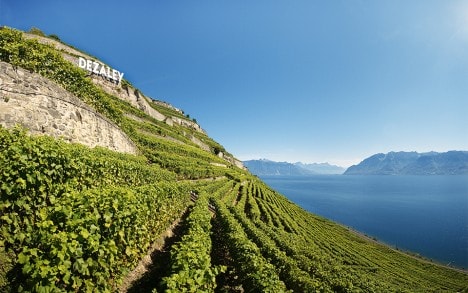
The Dézaley vineyards, well marked.
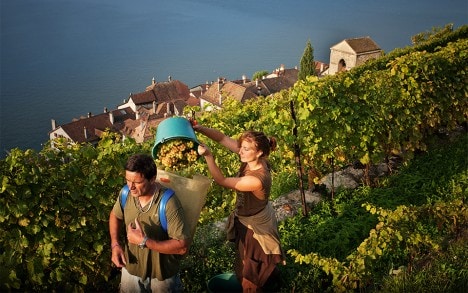
Harvest above Saint-Saphorin village.
Les Frères Dubois: A FAMILY DYNASTY The 1984 Dézaley-Marsens de la Tour is the wine that achieved THE BEST RESULTS AT THE 2013 CHASSELAS WORLD CHAMPIONSHIPS.
Les Frères Dubois [the Dubois brothers] are really branches of a much larger family tree. First came grandfather Marcel, then Christian, and finally his two sons Frédéric and Grégoire. The sons are also “coopers,” which is what consulting enologists who do cellar work for estates other than their own are called in Vaud. In this case, the Dubois brothers also craft wines for the Lavaux estates belonging to the City of Lausanne, including the two well-known Dézaley vineyards, Clos des Moines [The Monks’ Vineyard] and Clos des Abbayes [The Abbeys’ Vineyard]. These two names recall the historical connection with Cistercian monks.
Modern enology has also wreaked havoc in Lavaux. In the 1980s, a number of cellars stopped using large oak casks, replacing them with more easily cleaned stainless-steel vats, to avoid introducing any “off” tastes into the chasselas, that most delicate of all varietals. For their Dézaley-Marsens De la Tour, the Dubois brothers have brought aging on fine lees in tuns (large casks) back into favor. In the cellars beneath the manor house called Le Petit Versailles—today enlivened by a lovely wine bar!—at the entrance to the village of Cully, this would be Vase No. 4, with vase here being a French synonym for “cask.” Until 2008, the cask held 3,700 l, or the equivalent of 5,285 “Vaud” bottles of 70 cl each, continued use of which is allowedunder Swiss law despite the standardization of European measures (at 75 cl). Having disintegrated into its component staves, the first-generation Vase No. 4 was replaced by a new cask that holds 6,300 l, the equivalent of 9,000 bottles. This wine is not sold before it reaches two years of age.
Members of the Barony of Dézaley, the Dubois brothers offer older Dézaley vintages dating from 1971 on, from the most highly sought-after at 138 Swiss francs per bottle to the very young at 28 Swiss francs per bottle. The chasselas harvest for Vase No. 4 takes place around the Marsens Tower, a symbol of Lavaux that stretches its crenellations skyward. Only the best bunches of grapes from a 2.5-ha plot are selected for this special reserve. The grapes are harvested as late as possible in the fall— only once between 2002 and 2012 did the harvest begin before October 1, and that was in 2003, the year of the heat wave.
Concerning the second fermentation (malolactic fermentation, or “malo” for short), which is desirable for chasselas, Christian Dubois notes “without malo, only the varietal is expressed; with malo, you get the terroir.” The estate eagerly—and successfully!—seeks recognition at competitions. The 2009 vintage—named the second best Vaud chasselas, favorite of the 2013 Guide Hachette, gold medal at the Expovina competition in Zurich and at the International Chasselas Competition (Mondial du Chasselas, Aigle) held for the first time in 2012—is doing its part to showcase wines made from this varietal, of which canton of Vaud is the world’s leading producer with 2,320 ha (61% of its vineyards). And at the second event, the 1984 Dézaley-Marsens de la Tour was awarded the “best ranking in all categories of the Chasselas World Championships (with 93,8 points out of 100)”.
www.lesfreresdubois.ch
www.mondial-du-chasselas.com
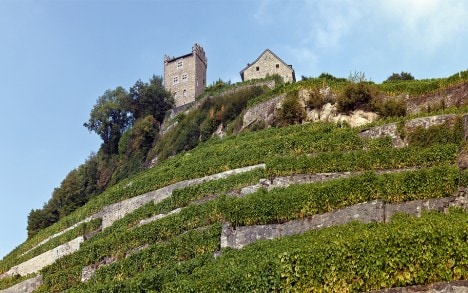

La Tour de Marsens, built at the beginning of the 13th century (attested 1272), the emblem of Lavaux and Dézaley, entirely located in the municipality of Puidoux.
Blaise Duboux: THE “PARKERIZED” PURIST HIS DÉZALEY WINES, AGED IN VATS ON FINE LEES, never touch oak casks or barrels.
At age 48, Blaise Duboux is proud to state that he represents the seventeenth generation of wine-growers from his family in Épesses. The ancestor who gave the family its name was a notable of Lausanne cathedral, Leopardo de Bosco, who emigrated from Turin in 1242 to care for Saint-Saphorin’s vines.
While the three other estates mentioned here are larger, this one comprises only 5 ha. “That’s the most you can do alone. I have only one full-time employee and some temporaries during the pruning and harvest seasons.” An enology engineer (ingénieur-œnologue) who graduated from Switzerland’s only school of enology, Changins, located between Lausanne and Geneva, he owns property in two grands crus: Calamin (0.5 ha) and Dézaley (1.5 ha).
This only child, the father of three teenage daughters, brought fermentation back to the family estate in 1988 and revived the entire operation in 2011. A former employee of Prométerre, a viticultural advisory institution, he has all the answers when it comes to Dézaley’s inherent good qualities. “The word terroir is still the one that describes it the best... the interaction of the soil, the parent rock, the water regimen, slope, and climate. Not to mention thatwhat we call the ‘three suns’—the sun itself, in the sky, and the double reflection from the lake and the terrace walls—create a real atomic reactor!”
Blaise Duboux produces two Dézaley wines. His Haut de Pierre represents a selection from a half-hectare parcel of old vines. “The oldest vine stock is 47 years old, the youngest 26.” In good years and bad, the parcel yields 3,000 bottles. The other, of which 12,000 bottles are made, is called Corniche, from the name of the panoramic drive that overlooks the Dézaley from the village of Épesses to Chexbres. “The Dézaley owes its reputation to the Cistercian monks. They were the ones who chose to clear the steepest slopes!” And it is exactly there, where the land is steepest, where the moraine has slid and the soil is “rubified,” that the vines from which he makes his Haut de Pierre grow.
A purist, Duboux says is is working “toward organic, sustainable viticulture.”Overtime, he has refined his fermentation. He tries to get along without industrial yeasts or, at worst, to use a generic yeast that guarantees dry wines. His Dézaley wines, aged in vats on fine lees, never touch oak casks or barrels.
Though not a member of the Barony of Dézaley, Blaise Duboux is the president of Arte Vitis, an association that for ten years has been bringing together thirteen of the best-known estates from canton Vaud and, since spring 2013, from the Lavaux wine-growing community. He was deeply touched by the fact that Robert Parkers’ magazine Wine Advocate recognized his Dézaley Haut de Pierre. “In every generation since the 19th century, a woman from our family has gone to the United States— New York, Los Angeles, or Florida.”
www.blaiseduboux.ch
www.arte-vitis.ch

Harvest time in Lutry, at Le Châtelard.
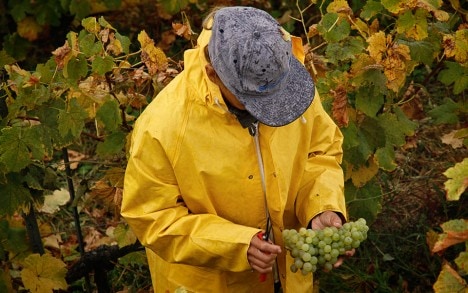
TASTING NOTES
Over several sessions, Pierre Thomas (PT) and Jeffrey S. Kingston (JK) tasted the four producers’ most recent Dézaley wines, and two older vintages.
MÉDINETTE 2011,
LOUIS BOVARD ESTATE, CULLY
Robust yellow; nose hints of anise with white flowers, warm stone; open; rather lively attack, unctuous in the middle range; good length, supple; finish yellow fruits and almond (PT). Nose evokes lemon peel tending toward apple and pineapple, vanilla notes in mid-palate; impressive structure; long spicy finish (JK).
MÉDINETTE 2008,
LOUIS BOVARD ESTATE, CULLY
Robust yellow; spicy nose (reminiscent of the 2011), notes of candied ginger; penetrating attack with aromas of candied lemon; good full-flavored finish; still young and fresh (PT). Pineapple nose; highly structured and very acidic; really dances in the mouth (JK).
MÉDINETTE 2001,
LOUIS BOVARD ESTATE, CULLY
Deep gold; nose redolent of preserves with a touch of mint and dried herbs, discreet hints of mushroom and forest undergrowth; orange peel and lime aromas in the mid-palate phase; power- ful; tertiary aromas already in evidence; complex, comes back to the acid side, a spirited wine with a final note of manda- rin (PT). Mineral and lemon-peel notes in the nose; a somewhat heavy, distinguished wine with average structure, tasting of a mixture of lime and herbaceous notes; its brilliance and freshness are impressive considering that it is 12 years old (JK).
DÉZALEY-MARSENS DE LA TOUR 2009, VASE NO. 4,
LES FRÈRES DUBOIS, CULLY
Yellow with golden highlights; open nose has good intensity with notes of very ripe yellow fruits, peach; full, mellow attack; unctuous with a buttery note; a rich, mature wine, distinguished and complex; persistent finish with honey and mineral notes (PT).
DÉZALEY-MARSENS DE LA TOUR 2004, VASE NO. 4,
LES FRÈRES DUBOIS, CULLY
Golden yellow; aromas of passion fruit and ripe mango in the nose are confirmed in the attack; very lively, magnificent volume with a rich mouth feel and persistence; cherry plum note in the finish; a very fine wine made from a late harvest (October 20) (PT).
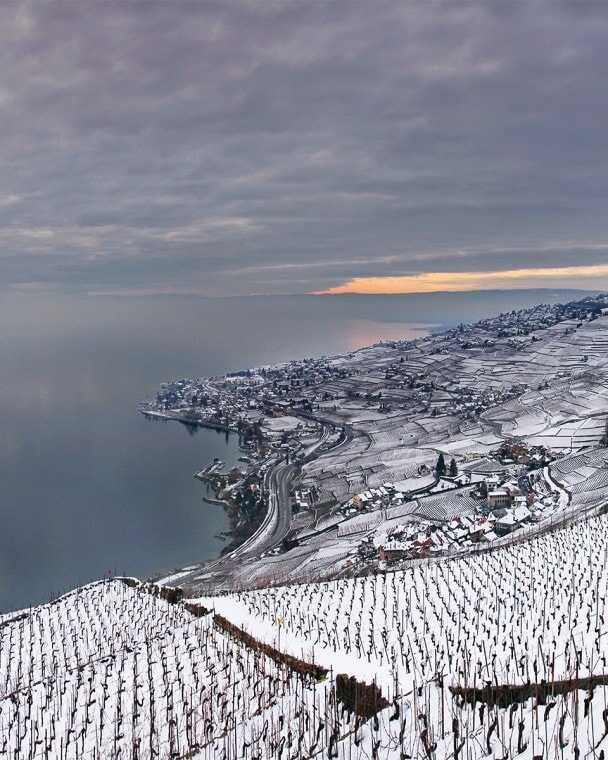
Vineyard above the Tour de Marsens, in winter.
DÉZALEY-MARSENS DE LA TOUR 2000, VASE NO. 4,
LES FRÈRES DUBOIS, CULLY
Golden highlights; nose of lemon verbena and candied lemon; nuances of toast £and spices in the attack; good volume on the palate; well-balanced, with notes of licorice and a slightly bitter aftertaste; very persistent (PT).
CHEMIN DE FER 2011, LUC MASSY, ÉPESSES
Robust yellow; buttery, lactic nose with subsequent aromas of ripe mango; begins with caramel attack; powerful and original; full-bodied, generous; finish with yellow fruits and almond (PT). Nose a little closed; perfect balance of sweet apple and honeysuckle; an elegant, subtle wine with a sweet finish (JK).
CHEMIN DE FER 2009, LUC MASSY, ÉPESSES
Very golden color; ripe sunny nose with hints of a match that has been struck; supple attack, candied fruits; rich, full, unctuous; low acidity; changing notes of acacia honey; candy-like finish similar to calissons from Aix-en-Provence (almond paste and lemon) (PT). An abundance of mineral and honeysuckle notes that burst forth in the nose; rich and round with a touch of overripeness; dried apricot; impressive finish; a focused, solid wine (JK).
CHEMIN DE FER 2000, LUC MASSY, ÉPESSES
Robust golden color; nose of dried banana, roasted hazelnuts, and dried fruits; full-bodied, unctuous attack; nice freshness; empyreumatic notes with almond milk and candy; a magnificent wine, unctuous, highly consistent and remarkably honest (PT). Spicy and vanilla notes in the nose with melon aromas; marvelously balanced (JK).
HAUT DE PIERRE 2011, BLAISE DUBOUX, ÉPESSES
Golden yellow; mineral nose with earthy impressions; crisp attack; rich mouth feel, sap (not tree sap!), mineral qualities; white flowers in mid-palate; powerful, almost tannic, holds up well in mid- palate and slightly salty with a little carbon dioxide (CO2) in the finish (PT). Mineral nose with lime flower notes; vanilla attack; round in the middle range with a marvelous dried apricot aroma; interesting contrast between the rather discreet, heavy nose and the open, luxuriant palate; extraordinarily rich and mature; sweet lemony finish (JK).
HAUT DE PIERRE 2010, BLAISE DUBOUX, ÉPESSES
Golden color; fine full nose with aromas of quince jelly, yellow fruits, sweet spices; full-bodied attack; fresh pear, mango, sweet spices; good complexity; a little CO2; generous long finish (PT). Spicy mineral nose, rich and round in mid-palate, with notes of sweet peach and vanilla; long finish (JK).
HAUT DE PIERRE 2003, BLAISE DUBOUX, ÉPESSES
Golden color, full creamy nose of panettone with lemon notes; attack reminiscent of gingerbread; long and fresh with candied fruits, a slight note of honey, and aromas of pear tart (PT). This vintage was made during the heat wave in Europe and the wine reflects that: nose of exotic fruits (passion fruit) mixed with bush peach and sweetened apricot; rich, ripe, and concentrated (JK).


